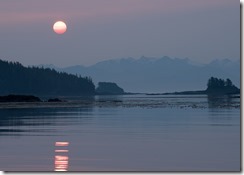After filling our water tanks and disposing of our trash/recyclables in Bartlett Cove we head east in Icy Strait than south down to Chatham Strait to Pavlof Harbor. There is a perfect “bear beach” in the anchorage which didn’t disappoint, with two youngster bears (perhaps only recently sent packing by their mother) in the evening and then a sow with two cubs the next morning.
We continued south in Chatham Strait and as we approached Kasnyku Bay we saw lots of whale activity. Since we had seen so little activity up to this point, we stopped the engine for a short time and drifted while listening to the whale exhalations. Since whales are mostly below the water (barring the very exciting breaches), often times it is the auditory “viewing” of whales that is most enjoyable. The sound of exhalations easily carry a mile across the open water on a calm day.  Just outside of Takatz Bay, our anchorage for the night, Marcia put a hook down and we trolled for salmon for an hour before going in. Lots of salmon jumping but not much biting.
Just outside of Takatz Bay, our anchorage for the night, Marcia put a hook down and we trolled for salmon for an hour before going in. Lots of salmon jumping but not much biting.
The next morning, July 18, we continued down to Warm Springs Bay, and fished for halibut outside the entrance. Marcia lost some bait to a wily fish but nothing to the bait with the hook in it. We crossed to the east side of Chatham Strait to try fishing at Kingsmill Point but the wind had kicked up at this point and we elected to go in for the night. The anchorage was a new one to us in Security Bay on Kuiu Island.
Bright and early the next morning, we were out at Kingsmill trolling for salmon on the morning bite. It was pretty clear that the coho/silver salmon had not started their run yet as a couple of hours of trolling yielded only a feisty pink salmon. We called it quits and headed over to Gut Bay for the night.
The next morning the plan was to continue the fishing activities but when we popped out into Chatham we changed our plans. An offshore ridge was forming giving SE Alaska  most sunny weather but as the ridge was building, the north winds were starting to build. Chatham Strait, which runs for 120 miles in a N-S direction (200 miles if you include Lynn Canal with which it connects), offers a perfect channel for the wind to run. We beat our way north to Red Bluff Bay. Turned out others had the same idea and we ended up in the outer bay rather than at the head.
most sunny weather but as the ridge was building, the north winds were starting to build. Chatham Strait, which runs for 120 miles in a N-S direction (200 miles if you include Lynn Canal with which it connects), offers a perfect channel for the wind to run. We beat our way north to Red Bluff Bay. Turned out others had the same idea and we ended up in the outer bay rather than at the head.
 The next morning, July 21, we beat our way across
The next morning, July 21, we beat our way across  Chatham Strait to Frederick Sound where the winds were light and the seas calm and worked our way up towards Pybus Bay. We spent 3 nights in the area during which Marcia caught two nice size halibuts. We also watched some glorious sunsets and moon rises. Both the sun
Chatham Strait to Frederick Sound where the winds were light and the seas calm and worked our way up towards Pybus Bay. We spent 3 nights in the area during which Marcia caught two nice size halibuts. We also watched some glorious sunsets and moon rises. Both the sun  and moon had an orange cast but we heard nothing about what might have contributed to it.
and moon had an orange cast but we heard nothing about what might have contributed to it.
Before we headed to Petersburg, We checked out a couple of anchorages we had not been to. The first was Hobart Bay and the second was Cleveland Passage. On Thursday, July 26, we docked in Petersburg at high slack when the currents are running less strong pass the docks.
After two nights in Petersburg, we caught the afternoon high tide through Wrangell Narrows and spent the night in St John Harbor on Zarembo Island, due south of the  entrance to Wrangell Narrows. From here we headed first to Thom’s Place and then to Santa Anna Inlet, doing some prawning along the way.
entrance to Wrangell Narrows. From here we headed first to Thom’s Place and then to Santa Anna Inlet, doing some prawning along the way.
All during the previous week or so, we were having stunningly clear skies, warm temperatures and calm winds. Most evenings were spent watching the sun go down from the flybridge and, this being Alaska, killing horse flies. But by this time, the forecasts were hinting of changes. On July 31, we made for Meyers Chuck (full size version of photo below), at the junction of Ernest Sound and Clarence Strait.

With an early start to catch the southbound ebb tide we arrived in Ketchikan on August 1 and will stay here a few days while some rain and high winds pass through.
Miles traveled this leg – 511.2; engine hours – 88.8
Total miles traveled – 2001.1; engine hours – 317.6
